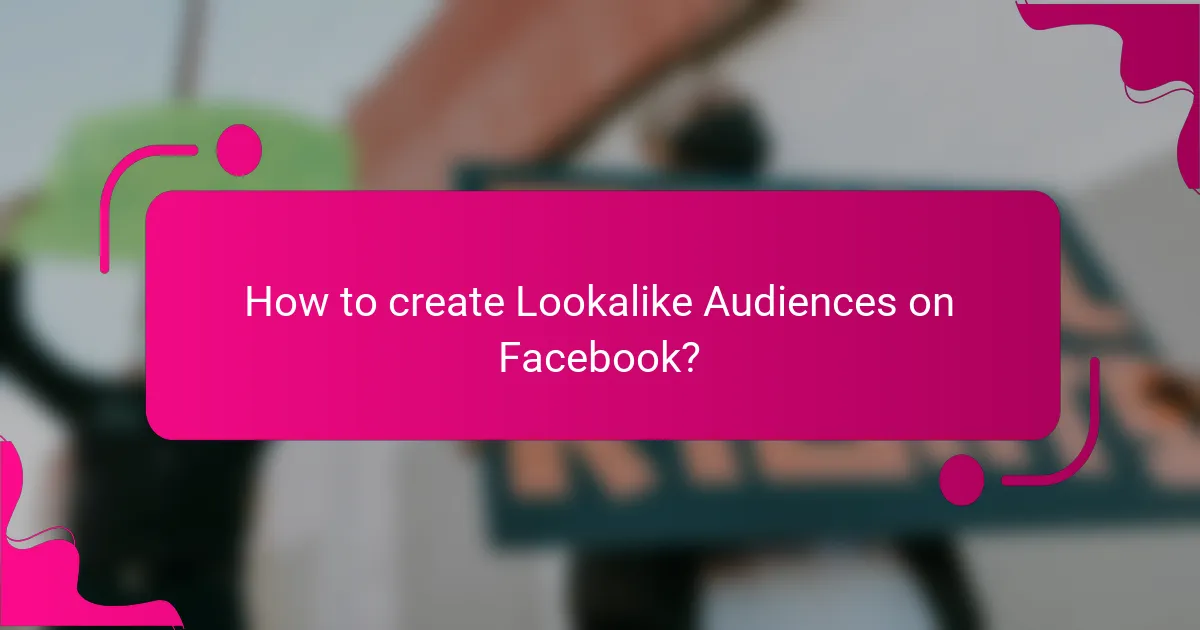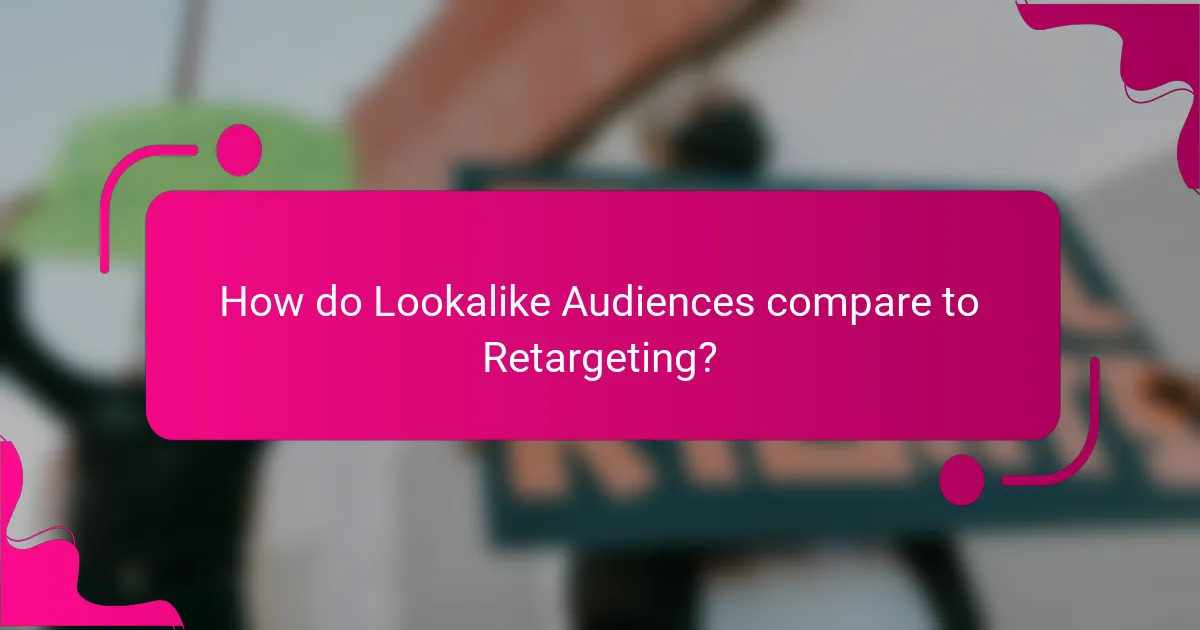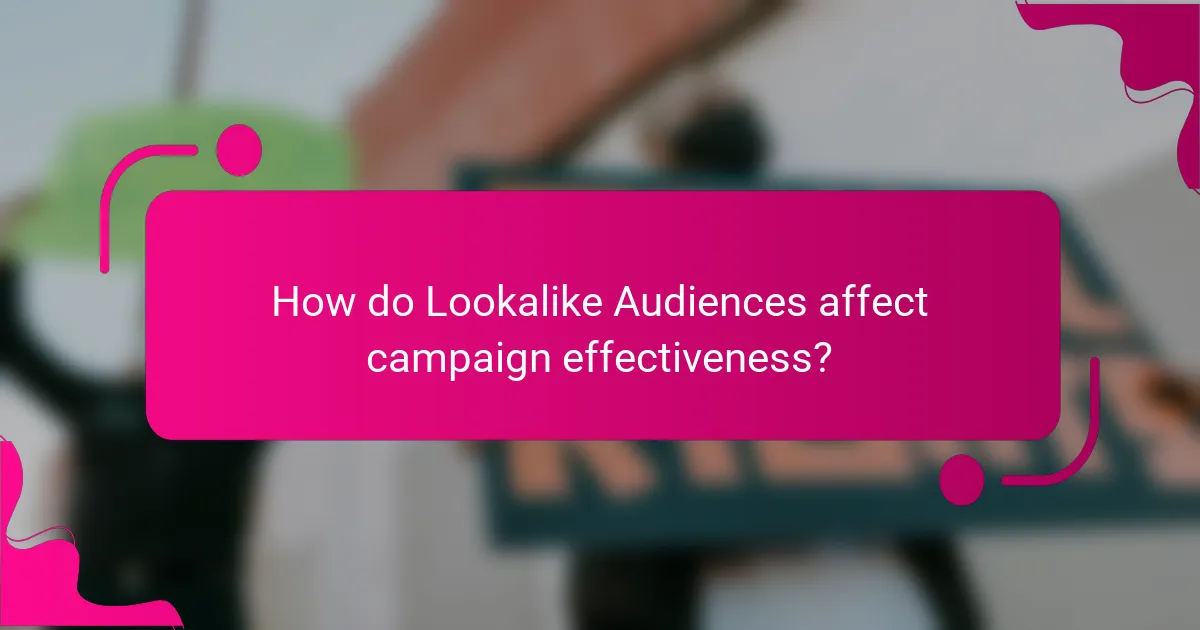Lookalike Audiences are a powerful marketing tool that enables advertisers to reach new potential customers who resemble their existing clientele. By leveraging data analysis, marketers can identify and target individuals likely to engage with their brand, thereby enhancing the effectiveness of their advertising campaigns. This approach not only optimizes targeting efforts but also increases the chances of conversion, making it a valuable strategy in display advertising.

How do Lookalike Audiences improve display advertising in the UK?
Lookalike Audiences enhance display advertising in the UK by allowing marketers to target users who share similar characteristics with their existing customers. This method increases the likelihood of engaging potential customers who are more likely to convert, thus optimizing advertising efforts.
Increased targeting precision
Lookalike Audiences enable advertisers to refine their targeting by identifying and reaching individuals who resemble their best customers. By analyzing data such as demographics, interests, and online behaviors, marketers can create highly specific audience segments that align closely with their ideal customer profile.
This precision means that ads are shown to users who are more likely to be interested in the product or service, reducing wasted impressions and improving overall campaign effectiveness. For instance, a UK-based fashion retailer can target users who have similar shopping habits to their existing loyal customers.
Higher conversion rates
By focusing on users who share traits with existing customers, Lookalike Audiences can lead to higher conversion rates. When ads are presented to a more relevant audience, the chances of engagement and purchase increase significantly.
For example, businesses in the UK have reported conversion rates that are often higher by tens of percent when using Lookalike Audiences compared to broader targeting strategies. This is particularly beneficial for e-commerce platforms looking to maximize their return on advertising spend.
Enhanced campaign ROI
Utilizing Lookalike Audiences can significantly enhance the return on investment (ROI) for advertising campaigns. By improving targeting and conversion rates, businesses can achieve better results without necessarily increasing their advertising budget.
In the UK, marketers can expect to see a more efficient allocation of their resources, as campaigns become more effective at reaching potential buyers. Tracking metrics such as cost per acquisition (CPA) can help businesses assess the financial benefits of using Lookalike Audiences in their advertising strategies.

What is a Lookalike Audience?
A lookalike audience is a marketing tool that allows advertisers to reach new users who share similar characteristics with their existing customers. By analyzing data from current customers, platforms can identify and target potential customers who are likely to engage with the brand.
Definition of Lookalike Audience
A lookalike audience is created by leveraging data from a source audience, such as existing customers or website visitors, to find new individuals who exhibit similar behaviors and demographics. This method enhances targeting efficiency by focusing on users who are more likely to convert based on their resemblance to the source group.
For instance, if a business has a strong customer base of young professionals, a lookalike audience can be generated to target other young professionals who have not yet interacted with the brand. This approach increases the likelihood of successful engagement and conversion.
How it differs from other audience types
Lookalike audiences differ from custom audiences and interest-based targeting. Custom audiences are built from specific user data, such as email lists or website visitors, while interest-based targeting focuses on users based on their declared interests and behaviors without necessarily resembling existing customers.
Additionally, lookalike audiences are generally broader and more scalable than custom audiences. They allow advertisers to expand their reach beyond their current customer base, whereas custom audiences are limited to known contacts. This distinction makes lookalike audiences particularly valuable for growth-oriented campaigns.

How to create Lookalike Audiences on Facebook?
Creating Lookalike Audiences on Facebook involves identifying a source audience and then using Facebook’s tools to find new users who share similar characteristics. This process enhances targeting and can significantly improve campaign effectiveness.
Step 1: Source audience selection
The first step in creating Lookalike Audiences is selecting a source audience, which can be based on existing customers, website visitors, or engagement with your content. Ideally, this source should consist of at least a few hundred users to ensure Facebook has enough data to work with.
Common sources include customer lists, website traffic tracked through Facebook Pixel, or engagement data from your Facebook page. Choose a source that reflects your ideal customer profile to maximize the effectiveness of your Lookalike Audience.
Step 2: Audience size and similarity settings
After selecting a source audience, you can adjust the audience size and similarity settings. Facebook allows you to choose an audience size ranging from 1% to 10% of the population in your target country, where 1% represents users most similar to your source audience.
Smaller percentages yield higher similarity but fewer users, while larger percentages increase reach but may dilute targeting accuracy. Experiment with different sizes to find the balance that works best for your campaign goals.

What are the best practices for targeting Lookalike Audiences?
To effectively target Lookalike Audiences, start by defining clear source audiences and continuously monitor performance. This approach ensures that your campaigns reach users similar to your best customers, maximizing engagement and conversion rates.
Segmenting source audiences
Segmenting your source audiences is crucial for creating effective Lookalike Audiences. By dividing your existing customer base into groups based on behaviors, demographics, or engagement levels, you can tailor your targeting more precisely. For example, you might create segments for high-value customers, frequent buyers, or users who have engaged with specific products.
Consider using data from various channels, such as website interactions, email engagement, or social media activity, to inform your segmentation. This will help you identify the most relevant characteristics to replicate in your Lookalike Audiences.
Testing different audience sizes
Testing various audience sizes is essential to find the optimal balance between reach and relevance. Lookalike Audiences can typically range from 1% to 10% of the population in your target market, with 1% being the closest match to your source audience. Start with a smaller percentage to ensure high similarity, then gradually expand to see how it impacts performance.
Monitor the results of each audience size to determine which yields the best return on investment. A smaller audience may convert at a higher rate, while a larger audience could provide more overall traffic.
Monitoring performance metrics
Regularly monitoring performance metrics is vital for optimizing your Lookalike Audience campaigns. Key metrics to track include conversion rates, cost per acquisition, and engagement rates. By analyzing these metrics, you can assess the effectiveness of your targeting and make necessary adjustments.
Utilize A/B testing to compare different Lookalike Audiences and refine your strategy based on data-driven insights. This iterative approach allows you to continuously improve your campaigns and achieve better results over time.

How do Lookalike Audiences compare to Retargeting?
Lookalike Audiences and Retargeting serve different purposes in digital marketing. While Retargeting focuses on re-engaging users who have previously interacted with your brand, Lookalike Audiences aim to reach new users who share similar characteristics with your existing customers.
Differences in targeting strategy
Retargeting targets individuals who have already shown interest in your products or services, often through website visits or previous purchases. This strategy relies on tracking user behavior to serve ads specifically to those who are already familiar with your brand.
In contrast, Lookalike Audiences use data from your existing customer base to find new potential customers. Platforms like Facebook and Google analyze your current audience’s demographics and behaviors to identify similar users, expanding your reach to those who may not yet know your brand.
Complementary use cases
Combining Lookalike Audiences with Retargeting can enhance campaign effectiveness. For example, you might first create a Lookalike Audience to attract new customers, then implement Retargeting to convert those who engage with your ads or visit your website.
Additionally, using Lookalike Audiences can help you scale your campaigns. Once you establish a solid Retargeting strategy, expanding your reach through Lookalike Audiences allows you to continuously bring in new prospects while nurturing existing leads.

What tools can enhance Lookalike Audience campaigns?
Several tools can significantly improve the effectiveness of Lookalike Audience campaigns by providing insights and optimization features. Utilizing platforms like Facebook Ads Manager and Google Ads Audience Insights can help marketers refine their targeting strategies and enhance campaign performance.
Facebook Ads Manager
Facebook Ads Manager is a powerful tool for creating and managing Lookalike Audiences. It allows advertisers to upload a source audience, such as customer lists or website visitors, and then generate a Lookalike Audience based on shared characteristics. This process can help reach new potential customers who are likely to engage with your brand.
When using Facebook Ads Manager, consider the size of your source audience; a minimum of 100 people is required, but larger lists typically yield better results. Additionally, you can adjust the audience similarity percentage, ranging from 1% to 10%, to balance between reach and similarity.
Google Ads Audience Insights
Google Ads Audience Insights provides valuable data for refining Lookalike Audience targeting. This tool analyzes user behavior and demographics to help identify potential customers who resemble your existing audience. By leveraging this information, advertisers can create more effective campaigns tailored to specific audience segments.
To maximize the benefits of Google Ads Audience Insights, regularly review the performance metrics of your campaigns. Look for trends in engagement and conversion rates to adjust your targeting strategies accordingly. Remember that audience insights can vary by region, so consider local preferences and behaviors when crafting your campaigns.

How do Lookalike Audiences affect campaign effectiveness?
Lookalike Audiences significantly enhance campaign effectiveness by enabling advertisers to reach new potential customers who share similar characteristics with their existing audience. This targeting strategy can lead to improved engagement and conversion rates, ultimately maximizing return on investment.
Impact on ad reach
Utilizing Lookalike Audiences can substantially expand your ad reach by connecting with users who resemble your best customers. This approach allows for targeting a broader demographic while maintaining relevance, which can lead to higher engagement rates. For instance, if your current audience consists of young professionals, a Lookalike Audience can help you find similar individuals in the same age group and location.
To optimize ad reach, consider the size of your source audience; a larger base can yield more accurate Lookalike Audiences. Generally, a source audience of at least a few hundred individuals is recommended to ensure effective targeting.
Influence on customer acquisition cost
Lookalike Audiences can lower customer acquisition costs by improving the efficiency of your advertising spend. By targeting users who are more likely to convert, you can reduce wasted impressions and clicks. This means that your cost per acquisition (CPA) may decrease, allowing for a more cost-effective marketing strategy.
To maximize the benefits, monitor your campaigns closely and adjust your targeting criteria based on performance metrics. If you notice that certain Lookalike Audiences yield higher conversion rates, consider reallocating your budget to focus on those segments, potentially leading to a more favorable CPA.
